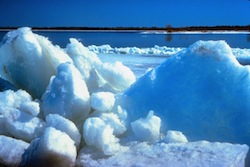SEJournal Online is the digital news magazine of the Society of Environmental Journalists. Learn more about SEJournal Online, including submission, subscription and advertising information.
TipSheet: Finding the Stories Beneath the Snow and Ice
Sure, you’d rather be skiing or skating right now. We know. But snow and ice are actually major news in many places at this time of year — and the basis of stories with big environmental consequences.
 Snow conditions at the local ski resort may be the first thing your editor asks about. So call it. Most ski areas update conditions right on their websites. The story doesn’t end there. Is climate change hurting snow-making? Does the water used dry up other uses — or increase surface runoff and groundwater recharge? Does it pollute? Is treated wastewater used? These issues have raged for decades.
Snow conditions at the local ski resort may be the first thing your editor asks about. So call it. Most ski areas update conditions right on their websites. The story doesn’t end there. Is climate change hurting snow-making? Does the water used dry up other uses — or increase surface runoff and groundwater recharge? Does it pollute? Is treated wastewater used? These issues have raged for decades.
Ice is big news as an indicator of global climate change. For example, the extent of seasonal sea ice in the Arctic has been shrinking, and climate is seen as the culprit. One place you can get reliable scientific reports is the National Snow and Ice Data Center (based in Boulder, Colo.), a partnership between federal science agencies and university research units. It offers intensive Arctic sea-ice reporting based on satellite and other data.
NSIDC’s purview goes way beyond that, though, to include ice sheets like the one in Greenland, and ice shelves like the ones in Antarctica, which are expected to cause a speed-up of sea-level rise by their melting. It even tracks the melting of permafrost, which releases carbon in a feedback loop that accelerates global warming.
Water-thirsty states often have a big stake in snowpack (the amount of snow that accumulates in the mountains over the course of a winter season), because the long spring melt is a source of water for irrigation, hydropower, drinking and industry. Unusually low snowpack has been one of the signals of California’s ongoing drought.
 |
| Image: © Clipart.com |
One excellent overview of snowpack in the arid West is the Natural Resources Conservation Service’s Snow Survey. Via the service’s National Water & Climate Center, you can also get related data about reservoir storage levels. NRCS also operates a SNOTEL system, which gives automated snow measurements via telemetry.
To track snowpack meaningfully, however, you probably want to check information sources at the state level and below. California, for example, does its own snowpack reports, as does Wyoming.
Snow cover — snow on the ground — matters in a lot of places. Several forecasters actually predict where “white Christmas” will occur (although it is a bit late for that now). They include the National Centers for Environmental Information and the Weather Channel. The Weather Channel also has a snow cover map, and the National Weather Service has a series of specialized snow cover maps. NCEI has a nifty animated map.
The impact of snow and ice on roads is especially important for drivers. Local news media often report road conditions via eyewitness reporting. But AccuWeather's road trip planner updates road conditions often, and Intellicast’s highway conditions map is a good way to track snow conditions on the interstates. State highway agencies can also be a good source.
Snow and ice underpin a hefty bunch of environmental stories you can also localize:
-
Road salt: Much of the “salt” used on roads and sidewalks contains chloride and can pollute surface and groundwater.
-
Ice on the Great Lakes: This limits the shipping season to less frigid months, with serious impacts on many local economies that depend on bulk cargoes. Ice also limits the shipping season on the upper Mississippi River.
-
Ice-fishing: A revered pastime in many communities surrounding inland lakes, it depends on both temperatures and the condition of the ice. State natural resource agencies that oversee fishing are often good sources of information.
-
Ice dams: Also known as “jams,” they form when the ice on frozen-over northern rivers breaks up in the spring — often causing flooding or damage to infrastructure such as bridges.
-
Ice skating: While indoor rinks may operate year-round, outdoor rinks (organized or impromptu) pop up when the weather gets cold. One good source of information will be local parks and recreation departments, which often operate the rinks.
* From the weekly news magazine SEJournal Online, Vol. 2, No. 1. Content from each new issue of SEJournal Online is available to the public via the SEJournal Online main page. Subscribe to the e-newsletter here. And see past issues of the SEJournal archived here.












 Advertisement
Advertisement 



